Mount options
When you have selected one or several blind layouts to suit your personal preferences, the information provided for each blind layout includes a list of the mount types suited to that layout.
The mount type (face, recess or window) determines where the blind is attached and how it fits over the window. Sometimes, the window type itself limits this option. For example, sliding windows which are stacked in front of each other generally do not allow enough space for blinds to be mounted directly to the window frame sash or glazing bead, but face or recess mounts may be appropriate. Similarly, hardware such as window handles that strongly protrude into the window reveal space may make a recess mount inappropriate; a face mount or direct window mount may be more suited.
The material (e.g. aluminium, timber, composite and uPVC) from which your window frames are made also determine which mount types are most appropriate. Face and recess mount options are generally suited to all window materials, as the blind is attached to the wooden architraves or window reveals surrounding the window. Attaching the blind directly to the window frame sash or glazing bead – a window mount – is a mount type generally used only for uPVC and some suitable timber windows, and we offer several window mount hardware fixings to match the various uPVC window styles available in Australia. A variety of clip-on and glue-on mounting options for uPVC windows are also available on request.

The information below briefly describes each of the mount types and the hardware fixings available for each of these methods. If you are uncertain about the suitability of any mounting hardware for your windows, we recommend ordering and testing one or several mount fixings here before ordering your blinds. We are also happy to provide advice over the phone or by email.
Mounting options for upright windows
Face mount (on architrave / trim)
The blind is mounted on the architrave parallel to the wall. It aligns with the architrave edges, so that the closed blind covers the window opening and the architrave. Where there is no architrave and the wall itself is suitably sturdy, the blind can be mounted directly to the wall in front of the window recess (we recommend mounting the blind with an additional 50 mm from each recess edge). Due to the slim design of the Decomatic rail system, the rails and blind will extend only c. 28 mm into the room (excepting the operating handle).
Suited to: All window types with components (handles, operating winders, bracing, etc.) that do not protrude past the window reveal’s edge. A minimum distance of 10 mm to window handles and other protruding components is recommended to avoid the blind brushing against these.
Fixing hardware: Face Bracket Mounts (+ Fixing Clips for stationary rails) (Stationary rails are always attached with Fixing Clips. This means that additional Fixing Clips are provided if you select a blind with a stationary rail; these fit directly and discreetly to the Face Bracket Mounts)
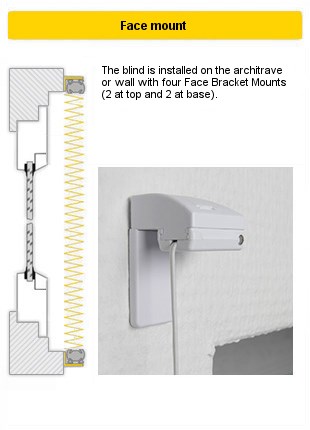
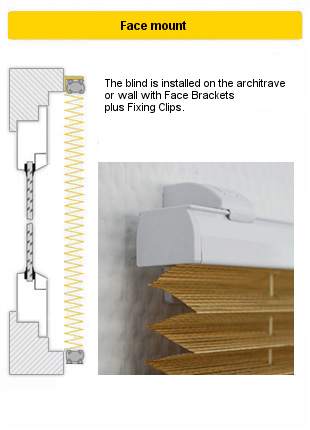
Face mount with Face Bracket Mounts for adjustable blind rails (left) and Face Brackets plus Fixing Clips for stationary blind rails (right).
Recess mount (inside window reveal)
This is the standard mounting option for most types of windows. The blind is measured to fit snugly within the window reveal, so that the closed blind covers the entire window opening within the window reveal. This option is visually particularly discreet, as the blind sits within the window reveal, rather than protruding into the room. The recess mount also allows less light into the room than a face mount, as the gaps along the lateral edges of the blind are smaller.
Suited to: All window types with adequate space (minimum 30 mm, more for some ceiling blinds) for mounting the blind within their window reveal. An additional distance of 10 mm to window handles and other protruding components is recommended to avoid the blind brushing against these.
Fixing hardware: Horizontal Mounts (Fixing Clips for stationary rails) Stationary rails are always attached directly to the window reveal with Fixing Clips, rather than with Horizontal Mounts.
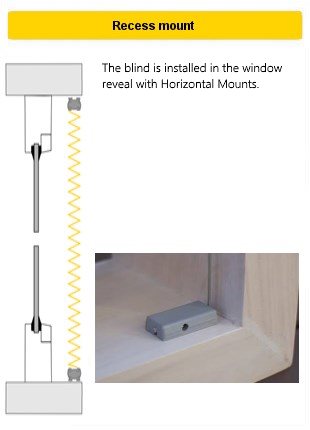
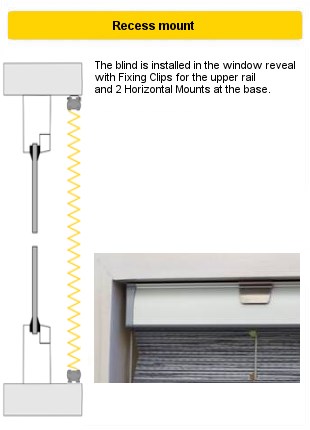
Recess mount with Horizontal Mounts for adjustable blind rails (left) and Fixing Clips for stationary upper rails (right).
Window mount (to window frame sash or glazing bead)
For some window types, blinds can be mounted directly to the window. This is especially useful for tilt & turn windows, where the window can be opened and closed without having to adjust the blind. The most popular and unobtrusive mounting location is in the glazing bead. Due to their lateral bracing and lack of free-hanging components, cordless blinds are the most suited to this mounting option. As window mounted blinds sit relatively close to the window glass, an adequate air gap must be maintained between the two materials to avoid damage to both. The minimum recommended gap is 3 mm for transparent and translucent fabrics, 5 mm for dim out and black out fabrics and 20 mm for honeycomb fabrics. Some window manufacturers recommend larger spacing.
Suited to: uPVC windows and some timber windows where a blind mounted to the window bead or window frame sash will not interfere in the normal opening operation of the window (generally not suited to aluminium or composite windows). Suitable window layouts include:
- Fixed/picture
- Tilt & turn
- Hopper
- Vertical and horizontal pivot
- Awning (without internal flyscreen)
- Casement (without internal flyscreen)
Window types NOT suited to window mounts include single and double hung windows, glider/slider windows, louvres, and awning/casement windows with internal flyscreens.
Fixing hardware options for uPVC windows:
- Horizontal Mounts – sit in the glazing bead. They require the glazing bead to have at least 15 mm depth. (Stationary upper rails are attached by Fixing Clips only, and require the glazing bead to have at least 25 mm depth).
- Slim Fit Mounts – sit in the glazing bead, and are specifically designed for very narrow glazing beads; the blind is mounted slightly away from the glass to avoid the blind fabric sliding against the glass. Not suited to blinds with fixed rails. Some timber windows may be suited to Slim Fit Mounts).
- Glazing Bead Mounts – sit on the glazing bead, by attaching to the vertical (room-facing) side of the glazing bead. (Stationary upper rails are attached by additional Fixing Clips).
Fixing hardware for suitable timber windows:
- Face Bracket Mounts – attach directly to the timber window frame sash. (Stationary upper rails are attached by additional Fixing Clips).
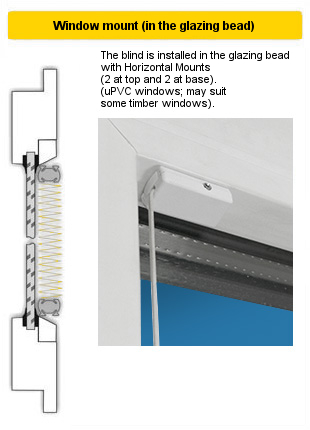
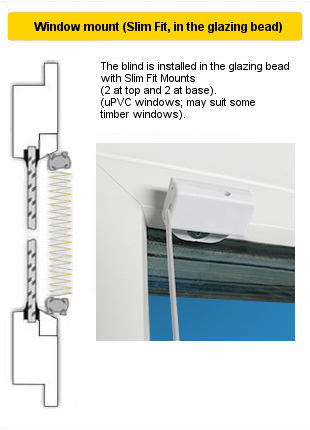
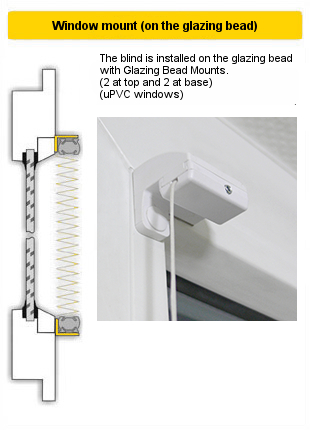
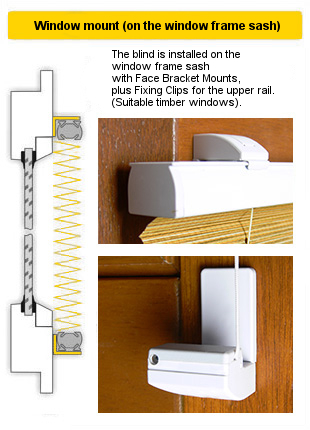
Window mount fixing hardware options. From left to right: Horizontal Mounts (uPVC), Slim Fit Mounts (uPVC), Glazing Bead Mounts (uPVC), and Face Bracket Mounts (suitable timber windows).
Mounting options for ceiling windows
Ceiling blinds differ from standard blinds through strengthening mechanisms such as wire tension cords or lateral rails (see Blind layouts). The blind model P3600 is suited to windows tilted up to 90° and can be recess or face mounted; the ‘Comfort’ range (P2616, P2601, P2621) is suited to windows tilted up to 60° and is recess mounted in the window reveal.The ‘Comfort’ range is available by special request only; please contact us for more information.
As for standard vertical windows, adequate distance to window handles and other protruding components is required to avoid the blind brushing against these. For any horizontal windows, we also recommend an air gap of at least 100 mm between the blind and the window glass to ensure adequate air circulation.
Fixing hardware options:
- Fixing Clips (Ceiling) are used to recess mount the P3600 blind. Additional Face Brackets can be used to face mount this blind.
- 'Comfort' systems with lateral rails are directly fixed to the window reveal using screws, and the cord tensioners are attached to mounts inside the lateral rails (blind layouts P2616, P2601, P2621).
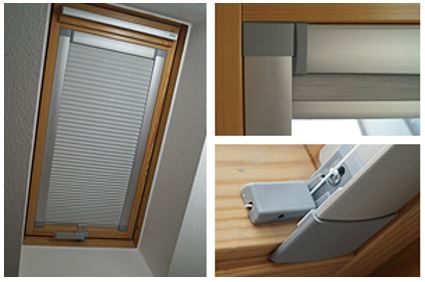
'Comfort' system mount using lateral rails (P2616, P2601, P2621)

